Oh man am I having trouble just writing all these sims... no matter I shall just have to move onto the next battle until the little grey cells start working again.
Last time on the Season of War, we had two of the greatest gunslingers of the 19th century battle it out to see who is better legendary figure - and surprisingly, the Kelly Gang made it out alive against the hero of the OK Corral. Now we do same thing again only this time using two of the bravest medieval legends - one a fiery female from the Orient, the other a knight of grace and honour from the Occident.
El Cid, the chivalrous Spanish noble who helped the Castilians drive out the Moors in the Reconquista...
vs
Tomoe Gozen, one of Japan's unsung and rare female samurai...
WHO... IS... DEADLIEST?
Let's Meet the Warriors[]
El Cid[]
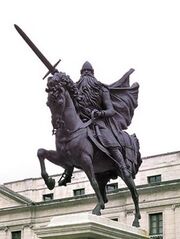
Rodrigo Díaz de Vivar, known as El Cid Campeador, was a Castilian nobleman, military leader, and diplomat. Exiled from the court of the Spanish Emperor Alfonso VI of León and Castile, El Cid went on to command a Moorish force consisting of Muladis, Berbers, Arabs and Malians, under Yusuf al-Mu'taman ibn Hud, Moorish king of the northeast Al-Andalus city of Zaragoza, and his successor, Al-Mustain II. {C}After the Christian defeat at the Battle of Sagrajas, El Cid was recalled to service by Alfonso VI, and commanded a combined Christian and Moorish army, which he used to create his own fiefdom in the Moorish Mediterranean coastal city of Valencia. Rodrigo Díaz was educated in the royal court of Castile and became the alférez, the chief general, of Alfonso VI, and his most valuable asset in the fight against the Moors.
(From Wikipedia)
| Sword | Tizona |
| Polearm | Voulge |
| Bow | Crossbow |
| Other | Flail, Colada |
| Armour | Chainmail Hauberk, Chestplate, Iron Helmet |
Tomoe Gozen[]
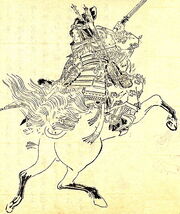
Tomoe Gozen (巴 御前?) (1157?–1247), was a late twelfth-century concubine of samurai general Minamoto no Yoshinaka, as well as a rare female samurai warrior (onna bugeisha), known for her bravery and strength. She is believed to have fought and survived the Genpei War (1180–1185) between the Minamoto and Taira clans.
While there is much variation on the stories concerning her, the texts are clear that Tomoe was one of the best martial arts practitioners of her day and was famed as a warrior of formidable skill.
Both Tomoe and Yoshinaka fought together in the Gempei War, which she is believed to have survived, unlike her master Yoshinaka. In one battle, she is reported to have single handily defended a bridge against dozens of attackers. In another, she is said to have killed many samurai warriors one after another in single combat and then killed their leader, Uchida Iyeyoshi. Attempting to drag her from her horse, Uchida infuriated Tomoe who promptly decapitated him and delivered his head as a trophy to Yoshinaka.
Her most famous story is from the Battle of Awazu (1184) where Yoshinaka was finally defeated by his enemies. When the battle was lost, Yoshinaka told Tomoe he will fight to the death but she should leave the battle field as he would be shamed to die fighting with a woman; after killing another opposing samurai warrior, she complied and escaped.
What happened after the battle, most sources contest. Some say she was captured by Minamoto no Yoritomo’s henchman Wada Yoshimori during the battle of Kyoto, forced to become his concubine, and then gave birth to the legendary strongman Asahina Saburo Yoshihide. Others say she became a Buddhist nun, reciting sutras on behalf of the late Lord Kiso no Yoshinaka’s soul until her death at the ripe old age of 91. Still others say she avenged Lord Kiso no Yoshinaka by killing his attackers, stealing back Yoshinaka’s head so no one else could defile it, and then walked out into the sea—head in hand—to drown.
| Sword | Tachi |
| Polearm | Naginata |
| Bow | Yumi |
| Other | Tanto, Koryu Martial Arts |
| Armour | Ō-yoroi |
Let's Examine the Weapons[]
Sword[]
Tizona[]

The Tizona, or Tizón, is one of the swords (together with La Colada) attributed to El Cid in Spanish literature. According to the Cantar de Mio Cid, El Cid won the sword from its previous owner, King Yucef in Valencia. Afterward, it was gifted by El Cid to his sons-in-law, the Infantes de Carrión but eventually returned into the possession of El Cid.
As a longsword, it was is 103 centimetres (41 in) long and weighs 1.1 kilograms (2.4 lb). Tizona was supposedly forged in Córdoba, though considerable amounts of Damascus steel can be found in its blade. The adornment of the sword has a plain pommel, a long and conical hilt, lined with iron; the hilt is curved and the sideboards contain spikes.
Tachi[]
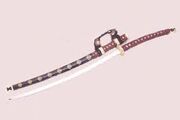
A tachi was a type of traditionally made Japanese sword worn by the samurai class of feudal Japan. The tachi style of swords preceded the development of the katana—the first use of the word katana to indicate a blade different from tachi appears toward the end of the twelfth century.
The tachi of Gozen's time period averaged 70–80 centimeters (27 9/16 - 31 1/2 in) in cutting edge length and compared to a katana was generally lighter in weight in proportion to its length, had a greater taper from hilt to point, was more curved with a smaller point area. Regarding the sword size, however, the stories of Gozen have made mention that she would be given an "oversized" sword - so for the purposes of this match, her tachi will have the maximum cutting edge length of 80 centimeters.
BG1's Edge[]
Ah the old longsword vs katana debate but with an interesting twist since the Japanese sword here is one that predates the katana - not to say outright that the tachi is inferior to the longsword at all. The tachi is light and aerodynamic while the longsword is longer and double-edged. To me, I will just call this a Tie since those two qualities put the swords on even ground.
Polearm[]
Voulge[]
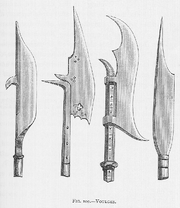
A voulge (occasionally called a pole cleaver) is a type of polearm that existed alongside the similar glaive in medieval Europe. Superficially, a voulge might strongly resemble a glaive, but there are some notable differences in construction. First, the attachment of the voulge blade to the shaft was usually done by binding the lower two thirds of the blade to the side of the pole; the glaive would often have a socket built into the blade itself and was mounted on top of the pole. In addition, while both had curved blades, that of the voulge was broad and meant for hacking, while that of the glaive was narrow and meant more for cutting. A voulge thus looks something like a squashed bardiche, or just a meat cleaver attached to a long pole. Since it resembles a glaive, it will most likely have the measurements of the glaive aside from surface area - around 45 cm (18 inches) long, on the end of a pole 2 m (6 or 7 feet) long.
Naginata[]
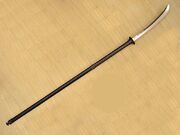
A naginata consists of a wooden pole with a curved single-edged blade on the end; it is similar to the Chinese guan dao or the European glaive. Similar to the katana, naginata often have a round handguard (tsuba) between the blade and shaft, when mounted in a koshirae. The 30 cm to 60 cm long naginata blade is forged in the same manner as traditional Japanese swords. The blade has a long tang (nakago) which is inserted in the shaft (nagaye or ebu).
The blade is removable and is secured by means of a wooden peg called mekugi that passes through a hole (mekugi-ana) in both the tang and the shaft. The shaft ranges from 120 cm to 240 cm in length and is oval shaped. The area of the shaft where the tang sits is the tachiuchi or tachiuke. The tachiuchi/tachiuke would be reinforced with metal rings (naginata dogane or semegane), and/or metal sleeves (sakawa) and wrapped with cord (san-dan maki). The end of the shaft has a heavy metal end cap (ishizuki or hirumaki). When not in use the blade would be covered with a wooden sheath.
BG1's Edge[]
Two very similar weapons but the naginata has the longer blade and longer shaft - furthermore the blade of the naginata can be detached which might not seem good if it gets knocked out in a melee with the voulge but otherwise it can be used as a surprise blade (if you think about it). For this I give a narrow edge to the Naginata.
Bow[]
Crossbow[]
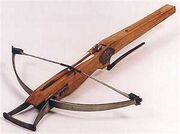
A Crossbow consists of a bow mounted on a wooden stock, with a mechanical string holding and release mechanism. This design allows the crossbow to aimed more easily, allowing effective use with minimal training. This design also allows the bow to be held drawn and ready to fire for extended periods of time, and allows for the use of mechanical devices such as stirrups, levers, cranks, and windlasses to pulled back the string with greater force than with muscle power alone.
Yumi[]

◾The yumi, or Japanese longbow, is a large bow and arrow that was a favorite of weapon of the Samurai of feudal Japan. The weapon holds the distinction of being the longest bow in the world, longer even than the English Longbow. The bow is typically about two meters in length, longer than the archer is tall. The yumi is traditionally made from a composite of wood and bamboo. The traditional wood and bamboo construction, combined with its great length, allows the bow to store large amounts of energy on the draw and release it with great force, giving a range of over 100 meters in the hands of a skilled archer.
Other[]
Flail[]
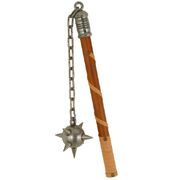
The one-handed flail is a hand weapon derived from the agricultural tool of the same name, commonly used in threshing. Only a limited amount of historical evidence exists for their employment in Europe during this era. These were deployed in Germany and Central Europe in the later Middle Ages. This weapon is generally depicted as a short wooden handle connected to one or many metal heads (often spiked) by way of a chain or chains.
Colada[]
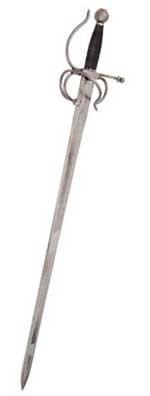
Colada is one of the two best-known swords, along with Tizona, of El Cid Campeador. Won in combat from the Count of Barcelona, the sword was presented (along with Tizona) to his sons in law. According to the heroic verses of the Cantar de mio Cid, after his sons-in-law beat his daughters and then abandoned them on the side of the road, El Cid asked for his gifts to be returned. Afterward, he bestowed the sword upon one of his knights, Martín Antolínez. [1]
Though its authenticity is doubted, a blade named Colada and traditionally identified with that of El Cid, with the addition of a 16th-century hilt, is preserved in the Royal Palace of Madrid.According to Sebastián de Covarrubias, Colada clearly means a sword made from "acero colado", a process of alloyed steel without impurities. As with Tizona, Colada appears in the epic poem Cantar de mio Cid as a sword that frightens unworthy opponents if wielded by a brave warrior. El Cid gives the sword to Martín Antolínez as a present, and he uses it in the duel against the infante Diego González.
Just like Tizona, it can be presumed that Colada is a longsword and thus will perhaps have the same dimensions as one albeit a bit shorter than Tizona (say 90 centimeters/35 inches). Also, since Tizona is the main sword of El Cid, Colada will simply be the back-up sword of El Cid should he lose Tizona.
Tanto[]
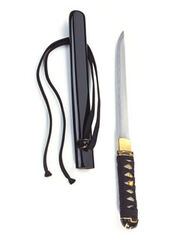
A tanto is commonly referred to as a knife or dagger. The blade is single or double edged with a length between 15 and 30 cm (6-12 inches). The tantō was designed primarily as a stabbing weapon, but the edge can be used for slashing as well. Tantō are generally forged in hira-zukuri style (without ridgeline), meaning that their sides have no ridge line and are nearly flat, unlike the shinogi-zukuri structure of a katana.
Koryū Martial Arts[]
Koryū (which translates to "old school") a general term for Japanese schools of martial arts that predate the Meiji Restoration of 1868. The system of koryū is considered in following priorities order: 1) combat, 2) discipline 3) morals. Within this system are a variety of martial arts skills that make use of the various Japanese weapons of the day - bojutsu with the bo staff, jujutsu aka jujitsu, jittejutsu with a jitte steel club, kenjutsu aka Japanese swordplay, kyujutsu with the yumi, naginatajutsu with the naginata, sojutsu with the yari spear and tantojutsu with the tanto dagger. Since Gozen was noted in her life stories to be very proficient in the martial arts, assume for this battle that she is a master of (primarily) jujutsu, naginatajutsu, kenjutsu, kyujutsu and tantojutsu.
Armour[]
Chainmail Hauberk, Chestplate, Iron Helmet[]
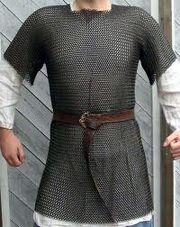
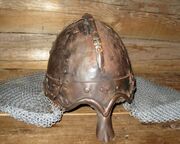
Although El Cid was no true "knight in shining armour", he was clad in the armour most knights of the early Middle Ages would wear - a chainmail hauberk shirt and plate armour that primarily covered his chest and shoulders (although not like the one you see the ideal knight wear) as well as an iron helmet shaped like the one you see in the title card.
Generally speaking, mail armour provided an effective defence against slashing blows by edged weapons and penetration by thrusting and piercing weapons. Mail, if a warrior could afford it, provided a significant advantage to a warrior when combined with competent fighting techniques. When the mail was not riveted, a well-placed thrust from a spear or thin sword could penetrate, and a pollaxe or halberd blow could break through the armour - though it's hard to determine whether El Cid's was or not (you decide for yourself).
Contrary to the film portrayal of El Cid he did not carry a heater shield as that was a late Middle Ages invention. For this battle, there will be no shield on El Cid.
Ō-yoroi/Samurai Lamellar[]
The ō-yoroi is a prominent example of early Japanese armor worn by the samurai class of feudal Japan. The term ō-yoroi means "great armor." The basic components of the ō-yoroi and other samurai armor are known collectively as the “hei-no-rokugu” or simply “rokugu,” which means six articles of arms - the dō (cuirass), kabuto (helmet), menpo (mask), kote (armoured sleeves), sune-ate (greaves), and the hai-date (cuisses). The ō-yoroi combines plate and scales (kozane) laced together (lamellar). One specific advance over earlier armors is that the kozane of ō-yoroi are first laced together and then covered with lacquer, which enhances resistance to corrosion. The dō of the ō-yoroi is unique from later models because it is composed of two separate parts instead of one piece with an opening on the side or back of the dō to allow the samurai to put on the armor.
The ō-yoroi (dō) consisted of two parts. One (the waidate) was a separate defense for the right side and the other part covered the rest of the wearer's trunk. The upper part of the waidate was solid iron plate covered with leather. The lower part was lamellar. When dressing for battle, the waidate was put on before the rest of the dō and fastened with cords that tied around the body. The rest of the dō was constructed with individual lacquered scales (kozane) laced together and covered with leather on top. The shoulder straps of the dō-yoroi, the watagami, were also unique from those on the dō-maru. The watagami were made of leather with attached metal plates. They were thicker and offered more protection than the straps on the dō-maru. The watagami of the dō-maru were eventually adopted because it was lighter and allowed more flexibility.
Facial armour (mengu) was worn to protect the samurai's face as part of the full yoroi. It was composed of iron or lacquered leather. Mengu could cover the entire face or only sections of it. There were many different types and styles of mengu. Specialized archery gloves yugake were made from deerskin and boots (kegutsu or tsuranuki) were made of bearskin or sealskin.
Ō-yoroi weighed around 30 kg/65 pounds, and the metal of choice was iron. Due to the weight of iron, armour makers limited its use to cover the vitals, and substituted leather for the rest.. One way to lower the weight was by alternating metal and leather kozane (scales) when constructing the rows of lamellar, creating a very strong armor with great flexibility and a more manageable weight.
Now onto the X-Factors[]
Table[]
| X-Factor | El Cid | Tomoe Gozen |
|---|---|---|
| Training | 90 | 90 |
| Experience | 94 | 89 |
| Physicality | 85 | 88 |
| Brutality and Audacity | 90 | 90 |
Explanations[]
- Training: There is no denying that the training of a samurai is pretty tough - especially for a lady like Tomoe but in order for her to become the onna bugeisha that she is most remembered as, she had to go through it all - including the Koryū Martial Arts listed above. I gave El Cid an equal score since the training to be a knight from a very young age can also be considered very tough (though it is debatable whether El Cid's martial capabilities were natural or nurtured).
- Experience: The only detailed account of Tomoe Gozen's exploits in battle are recounted in the Tale of the Heike which outlined the Genpei War of the late 12th century but there is nothing wrong in assuming that she has had experience as a samurai before then - after all by the time of the War, she had a big reputation behind her. El Cid gets the edge here however since he was one of the key fighters of the Spanish Reconquista and has fought for both Christian and Muslim armies within the Iberian peninsula.
- Physicality: There's no denying that El Cid may have been a very fit individual akin to Heston's portrayal in the film - after all he is a knight and thus will need to be very strong in order to move around with that armour and arsenal around the peninsula in moderate climates. Tomoe could have been given a lower score due to her female figure but since the written accounts have emphasised her strength/skill in archery, swordplay and horsemanship AND she has been described as going into battle with "strong armor, an oversized sword, and a mighty bow" then she is perhaps on par with, if not that little bit greater, El Cid on a physical level.
- Brutality and Audacity: I grouped these two together because they both deal with the capability and tenacity of each warrior to carry on the fight; and they're both even in that department. Aside from their legendary reputation on the battlefield, it is known that El Cid was an intelligent commander who was more than eager to employ psychological warfare against his opponents; and the samurai of which Tomoe was a part of have been shown to display no mercy and kill without fear and with the samurai mentality, she would most likely commit suicide as a last resort than admit defeat (which to me sounds like she would most likely continue fighting until she gives up and commits seppuku) although instead of committing seppuku at the end of the Battle of Awazu, she survived despite the loss of her army.
Now onto the battle[]
Battle[]
TBW
Expert's Opinion[]
Notes[]
- This will actually be a 1-v-1 duel that takes place at an outdoor public arena in Valencia (like that seen in the movie when Heston's Cid duelled in here)
- At first you might think that since this is a duel, this is going to be a battle to see who would be the first to give up - however, given the brutality and audacity X-Factor listed above, blood might get spilled eventually.
- Both warrior will initially start on horseback but it is most likely that both will end up on foot with their arsenals eventually.
- Voting ends when I say so. As for conditions for a vote to count? Common sense really - edges, more than 10 sentences, correct spelling, correct grammar and correct punctuation.

